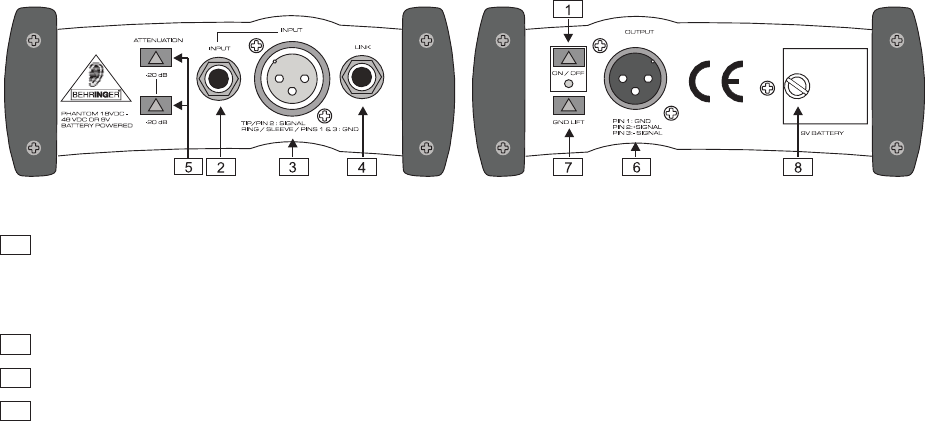
Welcome to BEHRINGER!
Thank you very much for expressing your confidence in BEHRINGER products by purchasing the ULTRA-DI.
DI stands for Direct Injection. On stage or in the studio there are sources you want to connect to your mixer that are
not equipped with a suitable connection. Keyboards seldom have properly balanced outputs. Guitars cannot be
directly plugged into a mixer and placing a microphone in front of a backline is not always ideal. A microphone picks
up ambient noise such as other instruments. Low frequencies (such as from a bass guitar) are especially difficult for
a microphone to handle.
A DI-box makes it possible to tap a signal from a high impedance unbalanced line, for instance the signal from a
guitar to a guitar amplifier, and Inject it Directly into the mixers input without having to use a microphone. But thats not
all, there are lots of situations where you want to inject the signal coming from an unbalanced source directly into your
mixer and preferably balanced, too. That is the application of a Direct Injection box.
Impedance is the electrical frequency dependent resistance of a device combined with its phase response. It is a
literally complex matter. That is why a good DI-box is distinguishable from a bad one. As with a power amplifier and
speakers the impedance to a device determines the performance. With a good power amplifier the load impedance
only affects the maximum power output. Whereas on some other devices the impedance governs other properties as
well. With a transformer as used in a DI-box, the connected impedances (in and out) influence the bandwidth,
frequency response, distortion, etc.
There are two basic types of DI-boxes, passive and active. Both active and passive DI boxes are designed to be
connected to the consoles microphone input. A passive DI box has the advantage of being slightly lower in cost (less
electronics, no battery facility) but their performance is highly dependent on the connected impedances. When the
impedance on the mixer side of a passive DI-box changes, the impedance on the input changes also. Not only that,
the frequency response changes, too. A passive DI-box only works well at specified connected impedances, high in
and low out, which means that they only work in a standard application.
Active DI-boxes dont have such restrictions. The signal coming from the input is buffered with an amplifier. The input
impedance of the ULTRA-DI is ultra-high so it doesnt affect the signal throughput at all. The output impedance of the
ULTRA-DI is balanced and very low so that it is much less susceptible to picking up hum and noise. This way, the
impedance for the signal source is independent from the impedance of the used mixer and vice versa. There is no
sound alteration. The transformer used is BEHRINGER´s renowned OT-1 witch guarantees distortion free, clean
sound and a flat frequency response. Furthermore the BEHRINGER ULTRA-DI can be powered by your consoles
phantom power or by battery and switches automatically between these two.
+ To avoid switching noise, you should mute the desk channel before activating the DI100.
Same applies when switching between battery and phantom power and vice versa.
The design of the DI100 includes four sturdy rubber feet which protect the unit (even during a unplanned drop) and
allow cables to run underneath. It also provides literally a ground lift so that the unit can be stacked on top of another
unit and other equipment without creating ground loops.
1. CONTROL ELEMENTS
Fig 1.1: Front & Rear DI100
1
With the ON/OFF switch you can switch the battery power on and off to preserve battery life. Switched off the
ULTRA-DI will still work on phantom power. Switched on, the ULTRA-DI will automatically switch between
battery and phantom power. When the DI100 is operating on battery power the ON/OFF LED will flash once
every few seconds, when operating on phantom power the LED will light up continuously.
2
INPUT. Connect the source to this 1/4" jack to receive the signal.
3
To provide maximum flexibility the ULTRA-DI is also fitted with an unbalanced XLR input to connect the source.
4
LINK OUT. This is the unbalanced parallel output of the ULTRA-DI. Connect this to the input of the backline or
monitor amplifier.
+ The 1/4" jacks (input and link out) and the Input XLR are wired parallel, so any connection as input will give
the same performance.






